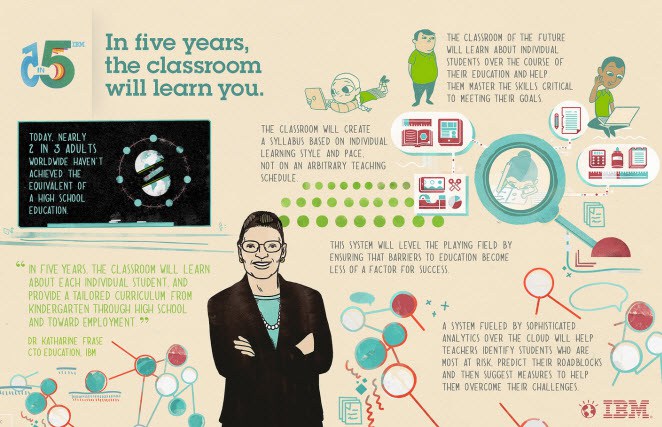IBM Predicts School of Future (5 years)
Posted: December 17th, 2013 | Author: Michael Goldstein | | No Comments »
 IBM says:
IBM says:
In five years, the classroom will learn you.
Globally, two out of three adults haven’t gotten the equivalent of a high school education. But IBM believes the classrooms of the future will give educators the tools to learn about every student, providing them with a tailored curriculum from kindergarten to high school.
“Your teacher spends time getting to know you every year,” Meyerson said. “What if they already knew everything about how you learn?”
In the next five years, IBM believes teachers will use “longitudinal data” such as test scores, attendance, student behavior on electronic learning platforms — and not just the results of aptitude tests. Sophisticated analytics delivered over the cloud will help teachers make decisions about which students are at risk, their roadblocks, and the way to help them.
IBM is working on a research project with the Gwinnett County Public Schools, the 14th largest school district in the U.S. in Georgia with 170,000 students. The goal is to increase the district’s graduation rate. And after a $10 billion investment in analytics, IBM believes it can harness big data to help students out.
“You’ll be able to pick up problems like dyslexia instantly,” Meyerson said. “If a child has extraordinary abilities, they can be recognized. With 30 kids in a class, a teacher cannot do it themselves. This doesn’t replace them. It allows them to be far more effective. Right now, the experience in a big box store doesn’t resemble this, but it will get there.”
Hmm. I would love to see a randomized control trial of IBM’s big data effort in Gwinnett (Atlanta). I’d love to bet the “under.” I.e., the dream is that “early identification” is what it takes to make a big difference in graduation rate.
But it hasn’t been that hard, even without the smarties from IBM, to figure out which kids in an inner-city system are at risk.
The bigger issue has long been the basic product (crappy school) and weak interventions. My alternative? See my Washington Post oldie but goodie.
There is surely a lot of promise in Big Data to help school design. Just unclear yet which parts and how.



Leave a Reply